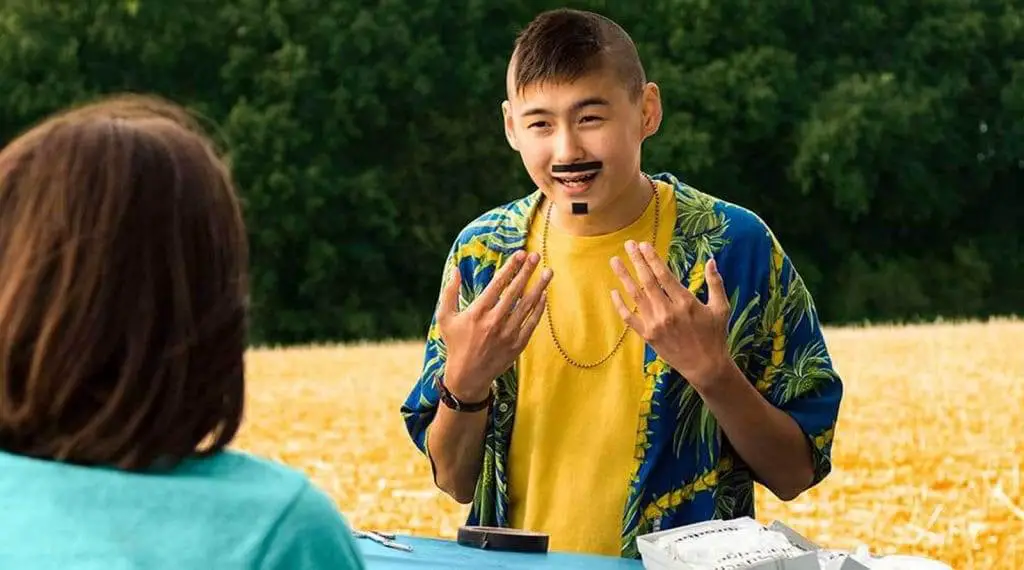
Now, don’t hold anything back, where did the song and concept for the “woman with the vagina made of glass” come from?
I watched a girl in shorts walking a bicycle down the sidewalk. She was lovely. I pulled a flyer off of a phone pole and wrote “The Girl With The Vagina Made Of Glass” on the back. It was meant as a compliment.
As a first-time director, did you experience any difficulty both starring in the movie and running the show behind the camera?
No. It was blast. There were times when we would argue, but that’s to be expected.
What was the budget (roughly) and exactly how did you secure the money?
After the Sundance screenwriter’s lab a lot of film companies were interested in reading my script. None of them liked it.
One night Bobby and I were playing a show with our band at the Knitting Factory in NY. Josh Taylor (aka. The Blueberry Pirate) was at that show. Bobby had done some consulting on a documentary that Josh had made in the past. Josh loved the band and asked what else we were up to. Bobby gave him the script, and he became interested. He put up his own money, and together he and Bobby raised the rest.
I made sure that the amount was never my business, but I can tell you that it cost a lot more than it looks like it did.
How did you go about casting?
Casting was one of the most fun parts of pre-production. Our casting director, Ann Goulder, would bring in exactly what I was looking for, as well as the opposite of what I wanted. On a couple of occasions we chose the opposite. The film is character-driven. I couldn’t be happier with who we chose.
The sets and costumes are clearly a big part of the film’s look, who designed them and what went into their development?
The Production Designer is an old friend of mine named Geoff Tuttle. He and I became friends working in a Chinese factory, painting faces on mannequins. Shortly after retiring I became head of security at a large night club. In the days, he and I would build things for the club, like steel Go-Go cages, and stages. We also worked on a series of comics together called, “Billy The Kid.” He had never done production design before, but we had a similar sense of humor and sense of æsthetics. Also, he had a master’s degree in fine arts from Stanford, so I figured he could do it.
Our Costume Designer was Dawn Weisberg. She did incredible things. All of the Southern Bell outfits on Venus were made out of shower curtains and hot-glue. The idea was that everyone wore the same clothes everyday, and the ladies of Venus needed something that they could clean easily.
The black and white cinematography is stark and striking, how did you achieve such a unique and impactful look?
The look of the film was thought out from the get-go. It started with the storyboard where I drew in the shadows. In pre-production we brought in W. Mott Hupfel III as our Director of Photography. He’s one of Josh Taylor’s oldest friends. He’s also married to Josh’s cousin. There aren’t a lot of B&W 35mm stocks to choose from. We picked the one with most contrast, opened the camera up wide and pumped a lot of light through it. Alan Jacobsen, our Gaffer, gave our sets their dimension and helped create and enforce the look of the film as well.
When you wrote the original script for The American Astronaut, the project was accepted into the Sundance Institute to be developed. Can you tell us about that process and how their support contributed to the project?
The Sundance screenwriter’s lab resulted in no changes to the script itself, but did change the way I looked at it. I had always seen the screenplay as part of a whole project, and not as a completed piece. Also, at the time I lived in a vacuum. No one had read my script. I was working on the storyboard constantly. I lived in a small hotel room, and was enployed at a strip club. The characters lived exclusively in my head. Then Sundance flew me to a mountain where people whose work I admired discussed my characters with me. Hearing how they felt about them had a big effect on how I saw and directed them. The food wasn’t bad either.
Did you set out to write a musical thinking that musicals would be coming back in a reinvented form? Was it your plan to reinvent the “rock musical”?
I started working on The American Astronaut in 1994. At that time there weren’t any musicals being made, nor did every other film have the word “American” in it’s title. My first three short films were musicals. I was never a huge fan of musicals, but in the mid 80’s I became a huge fan of Dennis Potter. He’s why I decided to make musicals. Writing musicals also brings another dimension to writing music.
Get the rest of the interview in the final chapter of CORY MCABEE BLASTS OFF>>>
